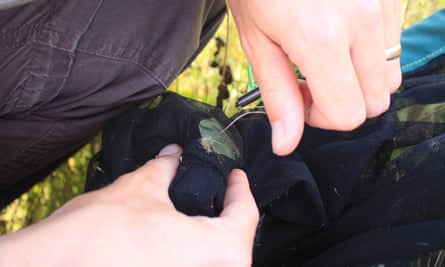Catching nearly 4,000 wild butterflies with handheld nets and taking the temperature of each tiny insect must rank among the more arduous of scientific endeavours.
However, researchers have discovered significant differences in the ability of British butterflies to maintain a suitable temperature, raising fears that global heating will threaten the populations of some species.
Butterflies are ectotherms – unable to generate their own body heat – and require warm temperatures to fly. However, extreme temperatures can pose problems, particularly for those butterflies that must find shady habitats to regulate their body temperature.
The study shows that larger, paler butterflies, such as the large white and brimstone, are best able to protect themselves from extreme temperatures, angling their reflective wings in relation to the sun to direct heat away from or on to their bodies.

Darker, large species, such as the peacock and red admiral, have greater difficulty controlling their body temperature, but even they are better than “thermal specialists”, which rely on finding a spot at a specific temperature in a landscape – a “microclimate” – to control their body temperature.
The species that depend on microclimate, such as the small copper and the brown argus, have suffered larger population declines over the past 40 years than species that regulate their temperature via their colour or by angling their wings.
“Butterfly species that aren’t very good at controlling their temperature with small behavioural changes, but rely on choosing a microhabitat at the right temperature, are likely to suffer the most from climate change and habitat loss,” said Dr Andrew Bladon, of the University of Cambridge, and lead author of the study.

“We need to make landscapes more diverse to help conserve many of our butterfly species. Even within a garden lawn, patches of grass can be left to grow longer – these areas will provide cooler, shady places for many species of butterfly. In nature reserves, some areas could be grazed or cut and others left standing. We also need to protect features that break up the monotony of farm landscapes, like hedgerows, ditches, and patches of woodland.”
After being caught in butterfly nets on British nature reserves, the 29 different species of butterflies’ temperatures were taken with a fine probe. The surrounding temperature of the butterfly’s perch, or air temperature, was also taken, which indicated the degree to which butterflies were seeking specific locations to regulate their body temperature.

The study, published in the Journal of Animal Ecology, found that butterflies were either “thermal generalists” or “thermal specialists”, and this different approach to regulating temperature did not always correspond to existing scientific categorisations. Butterflies are commonly viewed by conservationists as “habitat generalists” or “specialists” with the latter requiring targeted conservation work to preserve specific habitat, such as chalk grassland.
“As we plan conservation measures to address the effects of climate change, it will be important to understand not only the habitat requirements of different butterfly species, but also their temperature requirements,” said Dr Ed Turner, of the University Museum of Zoology, Cambridge, who led the work. “With this new understanding of butterflies, we should be able to better manage habitats and landscapes to protect them, and in doing so we’re probably also protecting other insects too.”
Landscapes with a structural diversity of heights and different features such as scrubland and grassland provide a greater range of temperatures than flat, monotonous ones, and can help create microclimates required by butterflies to regulate their temperature.
While global heating is broadly good news for warmth-loving butterflies, allowing many British species to expand their range northwards, the ranges of species adapted for cooler environments – such as the mountain ringlet – are shrinking. Conservationists fear that in a landscape where high-quality, diverse wild habitat is fragmented, butterflies will not easily be able to find new temperature-appropriate habitat.